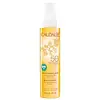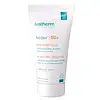What's inside
What's inside
 Key Ingredients
Key Ingredients

 Benefits
Benefits

 Concerns
Concerns

 Ingredients Side-by-side
Ingredients Side-by-side

Water
Skin ConditioningDicaprylyl Carbonate
EmollientVitis Vinifera Fruit Water
Skin ConditioningDibutyl Adipate
EmollientIsoamyl P-Methoxycinnamate
UV AbsorberPropanediol
SolventButyl Methoxydibenzoylmethane
UV AbsorberC20-22 Alkyl Phosphate
EmulsifyingEthylhexyl Triazone
UV AbsorberC20-22 Alcohols
Emulsion StabilisingBenzotriazolyl Dodecyl P-Cresol
UV AbsorberBis-Ethylhexyloxyphenol Methoxyphenyl Triazine
Skin ConditioningGlycerin
HumectantCaprylyl/Capryl Glucoside
CleansingParfum
Masking1,2-Hexanediol
Skin ConditioningCetearyl Alcohol
EmollientGlyceryl Stearate
EmollientSodium Hydroxide
BufferingPalmitoyl Grape Seed Extract
Skin ConditioningPicea Abies Wood Extract
Vitis Vinifera Juice
AntioxidantCitric Acid
BufferingO-Cymen-5-Ol
AntimicrobialPolyacrylate Crosspolymer-6
Emulsion StabilisingTocopheryl Acetate
AntioxidantXanthan Gum
EmulsifyingSodium Benzoate
MaskingPotassium Sorbate
PreservativeTocopherol
AntioxidantBenzyl Benzoate
AntimicrobialBenzyl Salicylate
PerfumingCitronellol
PerfumingGeraniol
PerfumingHexyl Cinnamal
PerfumingLinalool
PerfumingWater, Dicaprylyl Carbonate, Vitis Vinifera Fruit Water, Dibutyl Adipate, Isoamyl P-Methoxycinnamate, Propanediol, Butyl Methoxydibenzoylmethane, C20-22 Alkyl Phosphate, Ethylhexyl Triazone, C20-22 Alcohols, Benzotriazolyl Dodecyl P-Cresol, Bis-Ethylhexyloxyphenol Methoxyphenyl Triazine, Glycerin, Caprylyl/Capryl Glucoside, Parfum, 1,2-Hexanediol, Cetearyl Alcohol, Glyceryl Stearate, Sodium Hydroxide, Palmitoyl Grape Seed Extract, Picea Abies Wood Extract, Vitis Vinifera Juice, Citric Acid, O-Cymen-5-Ol, Polyacrylate Crosspolymer-6, Tocopheryl Acetate, Xanthan Gum, Sodium Benzoate, Potassium Sorbate, Tocopherol, Benzyl Benzoate, Benzyl Salicylate, Citronellol, Geraniol, Hexyl Cinnamal, Linalool
Water
Skin ConditioningDiethylamino Hydroxybenzoyl Hexyl Benzoate
UV FilterBis-Ethylhexyloxyphenol Methoxyphenyl Triazine
Skin ConditioningDicaprylyl Carbonate
EmollientPhenylbenzimidazole Sulfonic Acid
UV AbsorberDibutyl Adipate
EmollientEthylhexyl Triazone
UV AbsorberC20-22 Alkyl Phosphate
EmulsifyingC20-22 Alcohols
Emulsion StabilisingPolyacrylate Crosspolymer-6
Emulsion StabilisingDimer Dilinoleyl Dimer Dilinoleate
EmollientGlycerin
HumectantSodium Hydroxide
Buffering1,2-Hexanediol
Skin ConditioningBenzyl Alcohol
PerfumingChlorphenesin
AntimicrobialSodium Stearoyl Glutamate
CleansingSodium Chloride
MaskingTocopherol
AntioxidantWater, Diethylamino Hydroxybenzoyl Hexyl Benzoate, Bis-Ethylhexyloxyphenol Methoxyphenyl Triazine, Dicaprylyl Carbonate, Phenylbenzimidazole Sulfonic Acid, Dibutyl Adipate, Ethylhexyl Triazone, C20-22 Alkyl Phosphate, C20-22 Alcohols, Polyacrylate Crosspolymer-6, Dimer Dilinoleyl Dimer Dilinoleate, Glycerin, Sodium Hydroxide, 1,2-Hexanediol, Benzyl Alcohol, Chlorphenesin, Sodium Stearoyl Glutamate, Sodium Chloride, Tocopherol
 Reviews
Reviews

Ingredients Explained
These ingredients are found in both products.
Ingredients higher up in an ingredient list are typically present in a larger amount.
1,2-Hexanediol is a synthetic liquid and another multi-functional powerhouse.
It is a:
- Humectant, drawing moisture into the skin
- Emollient, helping to soften skin
- Solvent, dispersing and stabilizing formulas
- Preservative booster, enhancing the antimicrobial activity of other preservatives
You might know this ingredient as Tinosorb S or Bemotrizinol. It is a UV filter that covers both UVA and UVB rays.
This ingredient has two peak UV absorption peaks ( 310 and 340 nm) and is able to absorb both UV-A and UV-B rays. This ingredient works by preventing UV rays from reaching and damaging your skin.
On top of that - it is highly photostable and helps prevent the photodegration of other sunscreen ingredients such as avobenzone.
Tinosorb S is allowed in the EU, Australia, and Asia. It is close to being approved by the FDA and we'll hopefully get this ingredient in the U.S. by late 2025.
Fun fact: Tinosorb S is the most effective UV absorber at maximum concentration (measured by SPF) permitted in the EU.
This ingredient is oil-soluble, so your oil-cleansers will take this right off at night.
Learn more about Bis-Ethylhexyloxyphenol Methoxyphenyl TriazineWe don't have a description for C20-22 Alcohols yet.
We don't have a description for C20-22 Alkyl Phosphate yet.
Dibutyl Adipate is an emollient and solvent. It is created from butyl alcohol and adipic acid.
As a solvent, Dibutyl Adipate helps mix and disperse ingredients evenly.
Dibutyl Adipate is soluble in water and organic solvents. It does not absorb UV rays.
Learn more about Dibutyl AdipateDicaprylyl Carbonate comes from carbonic acid and caprylyl alcohol, a fatty alcohol. It is an emollient and gives skin a velvet feel. The sources of Dicaprylyl Carbonate may be synthetic or from animals.
As an emollient, Dicaprylyl Carbonate creates a film on the skin. This film traps moisture in, keeping your skin soft and hydrated.
Ethylhexyl Triazone is a modern chemical sunscreen that protects from UV-B radiation.
It is the most effective of existing UV-B filters, as it provides the highest level of photo-stable absorption. It protects from the entire UV-B range (280 to 320nm), with it's highest level of protection at 314nm.
Ethylhexyl Triazone is oil soluble, oderless and colorless, which mean it is able to be incorporated into a variety of different formulations.
It is not currently available within the United States due to slow changing FDA regulations. Outside of the US, it is used in formulations at concentrations up to 5%.
Learn more about Ethylhexyl TriazoneGlycerin is already naturally found in your skin. It helps moisturize and protect your skin.
A study from 2016 found glycerin to be more effective as a humectant than AHAs and hyaluronic acid.
As a humectant, it helps the skin stay hydrated by pulling moisture to your skin. The low molecular weight of glycerin allows it to pull moisture into the deeper layers of your skin.
Hydrated skin improves your skin barrier; Your skin barrier helps protect against irritants and bacteria.
Glycerin has also been found to have antimicrobial and antiviral properties. Due to these properties, glycerin is often used in wound and burn treatments.
In cosmetics, glycerin is usually derived from plants such as soybean or palm. However, it can also be sourced from animals, such as tallow or animal fat.
This ingredient is organic, colorless, odorless, and non-toxic.
Glycerin is the name for this ingredient in American English. British English uses Glycerol/Glycerine.
Learn more about GlycerinPolyacrylate Crosspolymer-6 is a texture enhancer and pH adjuster.
It is be used to thicken water-based products and create a gel-texture with a velvet feel.
One manufacturer claims this ingredient to have a pH range of 2-8 and to be biodegradable.
Learn more about Polyacrylate Crosspolymer-6Sodium Hydroxide is also known as lye or caustic soda. It is used to adjust the pH of products; many ingredients require a specific pH to be effective.
In small amounts, sodium hydroxide is considered safe to use. However, large amounts may cause chemical burns due to its high alkaline.
Your skin has a natural pH and acid mantle. This acid mantle helps prevent harmful bacteria from breaking through. The acid mantle also helps keep your skin hydrated.
"Alkaline" refers to a high pH level. A low pH level would be considered acidic.
Learn more about Sodium HydroxideTocopherol (also known as Vitamin E) is a common antioxidant used to help protect the skin from free-radicals and strengthen the skin barrier. It's also fat soluble - this means our skin is great at absorbing it.
Vitamin E also helps keep your natural skin lipids healthy. Your lipid skin barrier naturally consists of lipids, ceramides, and fatty acids. Vitamin E offers extra protection for your skin’s lipid barrier, keeping your skin healthy and nourished.
Another benefit is a bit of UV protection. Vitamin E helps reduce the damage caused by UVB rays. (It should not replace your sunscreen). Combining it with Vitamin C can decrease sunburned cells and hyperpigmentation after UV exposure.
You might have noticed Vitamin E + C often paired together. This is because it is great at stabilizing Vitamin C. Using the two together helps increase the effectiveness of both ingredients.
There are often claims that Vitamin E can reduce/prevent scarring, but these claims haven't been confirmed by scientific research.
Learn more about TocopherolWater. It's the most common cosmetic ingredient of all. You'll usually see it at the top of ingredient lists, meaning that it makes up the largest part of the product.
So why is it so popular? Water most often acts as a solvent - this means that it helps dissolve other ingredients into the formulation.
You'll also recognize water as that liquid we all need to stay alive. If you see this, drink a glass of water. Stay hydrated!
Learn more about Water